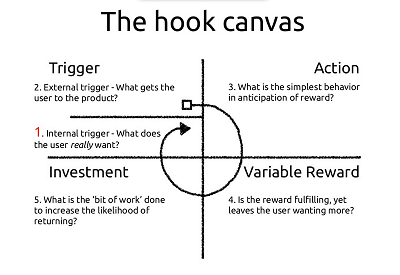The majority of new products fail to find long-term success. So, what will ensure your new innovations will make it past that important 12 months mark?
For a new product to find success, it requires consumers to change their current behaviours. Consumers are often intrigued to try a new product - however, for long-term success we need them to change their overall habits. Which is a lot harder than we believe.
The Hooked Model, originally developed by Nir Eyal for digital products, shows us the key principles a new product or service (in any sector) has to fulfil in order to become part of the consumer's long-term habits:

The Hooked Model is a perfect example on how to build products that will develop emotional connections with consumers - to prompt users to return and use those products over and over again. This enables the consumer to connect with the product and ultimately fall in love with the brand.
How does it work?
To create habit-forming products, you must move a user through a loop that over time develops the habit of returning and using that product over and over again. The basis of the relationship is an emotional reward - a deep needstate that creates a hook.
There are four key elements your new product or service must deliver:
1. Trigger
Why should a consumer try your product or service? In order to prompt trial you need to deeply understand the market and category. If nobody needs your product, it is bound to fail. The starting point for all product development should be to analyse the needs of current and potential customers, their levels of satisfaction from what is already on the market, what the competition is offering, consumption habits and the possibilities for improving existing products.
Our New Product Development tool will help you identify the most effective trigger and results in new product launches with a significantly higher chance of long-term success.
2. Action
The trigger is followed by the action. Taking action should be made as easy as possible for the consumer. This is a behaviour done in anticipation of reward. A reward is always based on an emotional payout. Consumers take action if they think they can avoid pain, gain pleasure, avoid social rejection, and so on. You need to be clear about the emotional payout your product delivers right from the outset of new product development. If there is more than one emotional benefit, then be clear about the hierarchy. Or maybe you think your product does not deliver any emotional payouts? Trust us, even the most rational service or practical product delivers an underlying emotional payout - we can help you find out what this is and leverage it to achieve faster adoption.
3. Variable Reward
This is what makes slot machines so addictive - every time you take action you get a different reward. So you want to have another go. Applying this principle to your new product will get consumers hooked. Variable rewards are one of the most powerful tools that businesses use to hook their consumers. As a result, dopamine (the happy hormone) is released. When dopamine is released, research suggests areas of the brain that are associated with judgement and reason are suppressed. Whilst parts associated with wants and desire come alive. Variable rewards for a digital product means developing different feedback loops, for a food product this can be achieved through usage suggestions (have you tried making a cocktail with this?) or launching new flavours in quick succession. Once people have made that first step to trial - reward them in as many ways as you can think of. Quickly.
4. Investment
The final stage of The Hooked Model, which helps you increase repeat usage, requires the user to do a little bit of work (invest time/effort/social capital or money). If consumers are willing to invest, this will increase their bond with the new product or service. This is easier to implement in certain product categories and also requires you to be sure the consumer has felt the reward and is at the correct stage of the process. Making the investment must deliver an even higher reward though, so make sure this is the case.
New Product Development is essentially Behavioural Change. Emotional Logic's tools combine psychology, neuroscience and behavioural economics to help you influence and change consumer behaviour. We can help you generate ideas for innovation, screen innovation concepts, accurately predict future sales and refine product features and packaging to maximise appeal. We support your New Product Development process at any stage from initial idea to fully designed prototype. Using our tools results in new product launches with a significantly higher chance of long-term success.
Get in touch today to discover how our New Product Development tool can help you throughout your product development.
